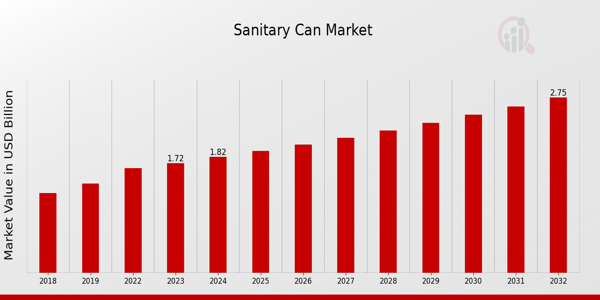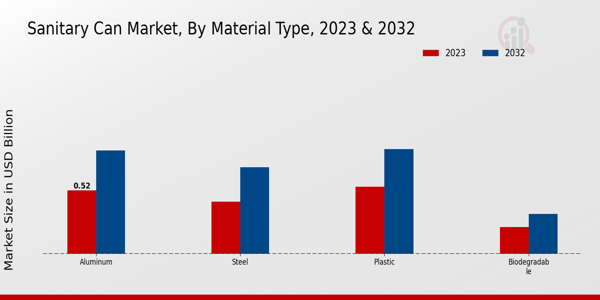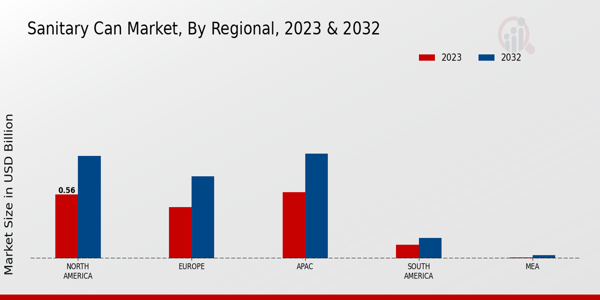Global Sanitary Can Market Overview
The Sanitary Can Market Size was estimated at 1.92 (USD Billion) in 2024. The Sanitary Can Industry is expected to grow from 2.02 (USD Billion) in 2025 to 3.22 (USD Billion) by 2034. The Sanitary Can Market CAGR (growth rate) is expected to be around 5.3% during the forecast period (2025 - 2034).
Key Sanitary Can Market Trends Highlighted
The Sanitary Can Market is rapidly expanding mainly due to new patterns of consumers and a rise in the hygienic concerns. The portable and easy to use sanitary fittings are increasing demand due to the focus on the self-care and convenience for women. This awareness has led to changes in features and designs of products and reaching out to more consumers who are eco-friendly as well as design and functional oriented. Further, rising urbanization and disposable income in the developing regions boost market demand for this segment providing the needed push. The potential in this market is enormous and especially for companies which harness biodegradable and sustainable materials.
As consumers become aware of the need to reduce the amount of pollution, it is apparent that there is a demand for products that will be sustainable. There is also more to be gained for brands that manage to engage or please these consumers. There are also potential partnerships with healthcare and wellness institutions that can help market these products better and create a presence in the less covered markets. They have also highlighted the potential for e-commerce networks to increase reach and sales of sanitary cans. Recently, the e-commerce network has shifted focus to the importance of personalization and customization as a selling point.
Nowadays, consumers wish to have more customized products in every aspect such as the size, scent and even the level of absorption of the products. These preferences are developed as brands make their way into the younger audience by the use of social media and influencer marketing. A growing popularity of subscription services that are both convenient and guarantee regular delivery is also apparent. In summary, moving forward the Sanitary Can Market will continue to transform to meet customer requirements but will also consider environmental issues.

Source: Primary Research, Secondary Research, MRFR Database and Analyst Review
Sanitary Can Market Drivers
Growing Awareness of Health and Hygiene Practices
The increasing awareness regarding personal health and hygiene practices is a significant driver for the Sanitary Can Market Industry. As individuals become more health-conscious, the demand for hygiene-related products, including sanitary cans, has significantly risen. The importance of maintaining cleanliness and sanitation, particularly in public facilities, schools, and workplaces, has led to the increased adoption of sanitary cans. They serve as essential items for waste disposal in environments where maintaining hygiene is paramount.Additionally, with a rise in disposable menstrual products and a growing focus on menstrual hygiene management, there is a pressing need for advanced sanitary disposal systems to ensure that products are disposed of discreetly and safely. This trend reflects a broader shift in consumer behavior toward prioritizing hygiene over traditional waste disposal methods. Consequently, the growth of the Sanitary Can Market is closely tied to ongoing education and awareness campaigns about the importance of hygiene, particularly in underserved and developing areas.This initiative is supported by governments and non-profit organizations who advocate for better sanitary practices. Furthermore, the rise of eco-friendly and sustainable products in the sanitary can segment has also contributed to the industry's growth, as consumers increasingly opt for environmentally responsible choices. Innovations in design and functionality tailored to meet consumer needs are helping to motivate purchasing decisions, thereby driving market expansion.
Expansion of the Healthcare and Hospitality Sectors
The rapid expansion of the healthcare and hospitality sectors significantly contributes to the growth of the Sanitary Can Market Industry. Hospitals, clinics, and hotels require efficient waste disposal methods to manage sanitary waste properly. With growing patient footfall in healthcare facilities and increased visits to hotels and restaurants, the need for sanitary disposal solutions has surged. Hospitals and care facilities are particularly focused on ensuring that sanitary waste is disposed of in compliance with health regulations to prevent any health risks.In the hospitality industry, timely waste management directly affects customer satisfaction and the overall cleanliness of the establishment, making sanitary cans a crucial part of their operational systems. The proliferation of these sectors fuels the demand for sanitary cans, aiding the market's upward trajectory.
Advancements in Product Technology
Advancements in product technology are another significant driver for the Sanitary Can Market Industry. Innovative designs and features are being introduced, such as touchless operation, odor control mechanisms, and recyclable materials. These enhancements not only improve the user experience but also contribute to sustainability. As the market embraces technology, businesses and consumers alike are encouraged to integrate modern sanitary disposal solutions into their facilities.The focus on developing smarter and more efficient products helps cater to a discerning audience that values convenience and ecological impact, thus driving market growth.
Sanitary Can Market Segment Insights
Sanitary Can Market Material Type Insights
In 2023, the Sanitary Can Market, which is projected to achieve a valuation of 1.72 USD Billion, showcases a variety of material types that significantly contribute to its overall performance. Within this market segmentation, Aluminum continues to play a crucial role, being valued at 0.52 USD Billion in 2023. This segment is characterized by its lightweight nature and recyclability, contributing to its significant position in the market, with an expected growth to 0.85 USD Billion by 2032. Steel, valued at 0.43 USD Billion in 2023, also holds a meaningful presence, known for its strength and durability, which aids in the safe packaging of sanitary products, and is anticipated to reach 0.71 USD Billion in the coming years. Plastic remains a vital material type, noted for its versatile applications within the sanitary can market. In 2023, this segment is valued at 0.55 USD Billion, and it has garnered prominence due to its cost-effectiveness and lightweight characteristics, leading to expectations of growth to 0.86 USD Billion by 2032. Lastly, the Biodegradable material type, although smaller in scale, is catching attention with a value of 0.22 USD Billion in 2023, driven by the growing demand for sustainable packaging solutions aimed at reducing environmental impact, with future expectations of increasing to 0.33 USD Billion. Across these material types, the Sanitary Can Market data indicates that the Aluminum and Plastic segments are particularly significant, demonstrating majority holding and reflecting shifting consumer preferences towards lightweight and environmentally friendly materials. The combination of these factors supports the overall market growth, showing that while Steel provides crucial durability, and Biodegradable materials address sustainability concerns, Aluminum and Plastic truly dominate the landscape in terms of valuation and future potential. Insights into the market trends highlight an increasing reliance on these materials within the Sanitary Can Market industry, driven by a mix of innovation, consumer demand for sustainability, and regulatory considerations, thereby creating both opportunities and challenges in this evolving marketplace.

Source: Primary Research, Secondary Research, MRFR Database and Analyst Review
Sanitary Can Market Capacity Insights
The Sanitary Can Market, valued at 1.72 USD Billion in 2023, is poised for growth as it embraces an inclusive range of capacities. Within this market, several capacities cater to varied consumer needs, reflecting diverse applications across industries. The segment of Less than 1 Liter fulfills compact requirements, ideal for personal use, thus enjoying a significant share. Meanwhile, the 1 to 3 Liters capacity offers versatility and practicality, making it a popular choice among healthcare facilities and households alike. The 3 to 5 Liters options are increasingly gaining traction, meeting the demands of industrial applications, where spill prevention and cleanliness are critical.Furthermore, the More than 5 Liters segment dominates due to its suitability for larger institutional settings, where volume and sturdiness are prioritized. The Sanitary Can Market statistics reveal a clear trend as manufacturers innovate to meet stringent hygiene standards, which acts as a growth driver. Market growth is further supported by rising sanitary awareness, though challenges such as raw material costs persist. Overall, the capacity segmentation of the Sanitary Can Market not only showcases a dynamic range of products but also reflects the evolving needs of consumers and industries alike.
Sanitary Can Market Application Insights
The Sanitary Can Market is poised for growth with a valuation at 1.72 billion USD in 2023, and has an optimistic outlook for the coming years. The application segment of the market encompasses various uses, including Household, Industrial, Medical, and Commercial applications. Each area plays a crucial role in driving market expansion, with the Household segment often representing a significant portion due to the increasing focus on hygiene and waste management practices in residential areas. The Industrial sector has gained importance due to stricter regulations and safety measures in workplaces, while the Medical application is critical in maintaining hygiene standards in healthcare settings.The Commercial realm also demonstrates substantial demand from businesses prioritizing cleanliness in customer-facing environments. Overall, the dynamics within these applications highlight key growth drivers, alongside challenges such as regulatory compliance and competition in the Sanitary Can Market industry. The market statistics reflect an upward trajectory fueled by innovation and the need for effective waste disposal solutions across these diverse applications.
Sanitary Can Market Design Type Insights
The Sanitary Can Market, valued at 1.72 USD Billion in 2023, showcases significant growth potential within its Design Type segmentation. This encompasses Standard Design, Customized Design, and Eco-friendly Design, each offering unique value propositions. Standard Design remains a staple due to its cost-effectiveness and widespread acceptability in various sectors. In contrast, Customized Design has gained traction, catering to specific client needs and preferences, making it vital for manufacturers aiming to differentiate their products.Meanwhile, Eco-friendly Design is increasingly important due to rising environmental awareness, attracting a conscientious consumer base seeking sustainable options. As the market evolves, these design types not only contribute variably to the overall Sanitary Can Market revenue but also reflect broader trends such as innovation, sustainability, and consumer customization, vital for assessing Sanitary Can Market data and statistics. The interplay of these design types highlights both growth opportunities and challenges in adapting to changing consumer demands, ultimately influencing the overall market growth trajectory between 2024 and 2032.
Sanitary Can Market Regional Insights
The Sanitary Can Market exhibits significant growth in various regions, with a complete market valuation of 1.72 USD Billion in 2023 and projected growth to 2.75 USD Billion by 2032. Within this regional segmentation, North America leads with a valuation of 0.56 USD Billion in 2023, growing to 0.9 USD Billion in 2032, showcasing its dominance and contribution to the market. Europe follows, valued at 0.45 USD Billion in 2023 and rising to 0.72 USD Billion in 2032, indicating its important role in market growth. The APAC region shows a similar trend, starting at 0.58 USD Billion in 2023 and reaching 0.92 USD Billion in 2032, benefiting from increasing urbanization and a rising middle class.South America and MEA represent smaller market shares, with valuations of 0.12 USD Billion and 0.01 USD Billion in 2023, respectively, and projected increases to 0.18 USD Billion and 0.03 USD Billion by 2032. While these regions hold the smallest portions of the Sanitary Can Market revenue, they present growth opportunities driven by evolving consumer preferences and sanitation demands. Overall, the Sanitary Can Market statistics underscore a vibrant landscape with diverse regional contributions and a positive outlook for future expansion.

Source: Primary Research, Secondary Research, MRFR Database and Analyst Review
Sanitary Can Market Key Players and Competitive Insights
The competitive landscape of the Sanitary Can Market is characterized by a diverse array of companies vying for market share through innovative products, enhanced manufacturing processes, and effective distribution strategies. As environmental concerns grow, companies are focusing on developing sustainable and eco-friendly can solutions to meet consumer demands, which indicates a notable shift in industry dynamics. The overall market is expanding, driven by increasing urbanization, rising disposable incomes, and a growing awareness of health and hygiene practices that bolster demand for sanitary products. Furthermore, competitive strategies including mergers and acquisitions, partnerships, and investments in technological advancements are shaping the future of the market, as key players aim to improve efficiency and reduce costs while maintaining high quality standards in their offerings.In the context of the Sanitary Can Market, CocaCola Company holds a substantial market presence characterized by robust brand recognition and trust. The company’s commitment to sustainability serves as a significant strength, as it actively pursues initiatives aimed at reducing the environmental impact of its packaging, therefore aligning with the growing consumer preference for eco-conscious products. CocaCola's extensive distribution network allows it to efficiently deliver its sanitary can products to various regions, ensuring widespread availability. The company also invests in innovation, continuously improving its can designs and materials to enhance functionality while ensuring consumer safety. Moreover, CocaCola's strategic marketing campaigns and established relationships with retailers contribute to its strong competitive position, enabling it to maintain a leadership role within this market segment.Ardagh Group is another key player in the Sanitary Can Market, distinguished by its focus on sustainability and quality in packaging solutions. The company's extensive range of metal and glass products showcases its ability to cater to diverse customer needs, fostering long-term partnerships with various industries. Ardagh Group's strengths lie in its advanced manufacturing capabilities, which emphasize efficiency and innovation, leading to cost-effective production processes. This operational agility allows the company to adapt quickly to market demands and consumer trends. Furthermore, Ardagh Group prioritizes research and development to create products that not only meet regulatory standards but also appeal to the ecological concerns of today's consumers. With a strong global footprint, the company is well-positioned to leverage its capabilities in order to expand its presence and drive growth within the competitive arena of the sanitary can market.
Key Companies in the Sanitary Market Can Include
- CocaCola Company
- Ardagh Group
- Mondi Group
- PepsiCo
- Karma Mgt
- Crown Holdings
- Amcor
- Guala Closures
- Silgan Holdings
- AnheuserBusch InBev
- Nampak
- Berk Company
- Ball Corporation
- Tetra Pak
- Alcan Packaging
Sanitary Can Market Industry Developments
Recent developments in the Sanitary Can Market have shown significant growth driven by rising consumer awareness regarding packaging sustainability and health safety. Key players like CocaCola Company, PepsiCo, and Ball Corporation are focusing on developing eco-friendly packaging solutions, leading to increased market valuation. For instance, the impact of innovative can designs and sustainable materials has been notable, influencing both production efficiency and consumer preferences. Furthermore, the demand for specialty cans for beverages has created opportunities for companies like Crown Holdings and Amcor to expand their product lines. In terms of mergers and acquisitions, companies have been actively seeking strategic partnerships to enhance their market positions; Guala Closures and Silgan Holdings have recently been involved in discussions to amplify their product offerings. The consolidation of capabilities among these organizations is expected to result in more streamlined operations and improved technological advancements. The rise in e-commerce and online sales channels has further bolstered market dynamics, particularly for companies like Tetra Pak and Ardagh Group, making it an exciting time for the Sanitary Can Market.
- Sanitary Can Market Segmentation Insights
- Sanitary Can Market Material Type Outlook
- Aluminum
- Steel
- Plastic
- Biodegradable
- Sanitary Can Market Capacity Outlook
- Less than 1 Liter
- 1 to 3 Liters
- 3 to 5 Liters
- More than 5 Liters
- Sanitary Can Market Application Outlook
- Household
- Industrial
- Medical
- Commercial
- Sanitary Can Market Design Type Outlook
- Standard Design
- Customized Design
- Eco-friendly Design
- Sanitary Can Market Regional Outlook
- North America
- Europe
- South America
- Asia Pacific
- Middle East and Africa
| Report Attribute/Metric |
Details |
| Market Size 2024 |
1.92 (USD Billion) |
| Market Size 2025 |
2.02 (USD Billion) |
| Market Size 2034 |
3.22 (USD Billion) |
| Compound Annual Growth Rate (CAGR) |
5.3% (2025 - 2034) |
| Report Coverage |
Revenue Forecast, Competitive Landscape, Growth Factors, and Trends |
| Base Year |
2024 |
| Market Forecast Period |
2025 - 2034 |
| Historical Data |
2020 - 2024 |
| Market Forecast Units |
USD Billion |
| Key Companies Profiled |
CocaCola Company, Ardagh Group, Mondi Group, PepsiCo, Karma Mgt, Crown Holdings, Amcor, Guala Closures, Silgan Holdings, AnheuserBusch InBev, Nampak, O.Berk Company, Ball Corporation, Tetra Pak, Alcan Packaging |
| Segments Covered |
Material Type, Capacity, Application, Design Type, Regional |
| Key Market Opportunities |
Rising awareness of hygiene, Expansion in developing markets, Innovative eco-friendly materials, Increased demand in healthcare sector, Collaboration with e-commerce platforms |
| Key Market Dynamics |
Rising hygiene awareness, Growing urbanization trends, Increased demand for eco-friendly products, Expansion in healthcare facilities, Technological advancements in sanitation |
| Countries Covered |
North America, Europe, APAC, South America, MEA |
Frequently Asked Questions (FAQ) :
The Sanitary Can Market is expected to be valued at 3.22 USD billion in 2034.
The expected CAGR for the Sanitary Can Market from 2025 to 2034 is 5.3%.
North America is projected to dominate the Sanitary Can Market with a value of 0.90 USD billion by 2034.
The Aluminum segment of the Sanitary Can Market is expected to reach 0.85 USD billion by 2034.
Key players in the Sanitary Can Market include CocaCola Company, Ardagh Group, and Crown Holdings among others.
The Plastic segment is expected to be valued at 0.86 USD billion in the Sanitary Can Market by 2034.
The South American market for Sanitary Can is projected to grow to 0.18 USD billion by 2034.
The Steel segment of the Sanitary Can Market is expected to reach 0.71 USD billion by 2034.
The MEA region's market for Sanitary Can is expected to be valued at 0.03 USD billion in 2034.
The Biodegradable segment is projected to be valued at 0.33 USD billion in the Sanitary Can Market by 2034.

















